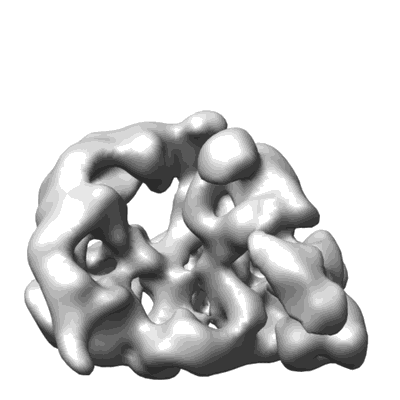EMD-1842
Structural basis for the subunit assembly of the anaphase promoting complex
EMD-1842
Single-particle Deposition: 04/12/2010
Deposition: 04/12/2010Map released: 11/02/2011
Last modified: 11/02/2011
Sample Organism:
Saccharomyces cerevisiae
Sample: APC (Cdc27 and Apc9 deleted)
Deposition Authors: Schreiber A ,
Stengel F
,
Stengel F  ,
Zhang Z
,
Zhang Z  ,
Enchev RE,
Kong E,
Morris EP
,
Enchev RE,
Kong E,
Morris EP  ,
Robinson CV
,
Robinson CV  ,
daFonseca PCA,
Barford D
,
daFonseca PCA,
Barford D
Sample: APC (Cdc27 and Apc9 deleted)
Deposition Authors: Schreiber A
 ,
Stengel F
,
Stengel F  ,
Zhang Z
,
Zhang Z  ,
Enchev RE,
Kong E,
Morris EP
,
Enchev RE,
Kong E,
Morris EP  ,
Robinson CV
,
Robinson CV  ,
daFonseca PCA,
Barford D
,
daFonseca PCA,
Barford D
Structural basis for the subunit assembly of the anaphase-promoting complex.
Schreiber A  ,
Stengel F
,
Stengel F  ,
Zhang Z
,
Zhang Z  ,
Enchev RI,
Kong EH,
Morris EP
,
Enchev RI,
Kong EH,
Morris EP  ,
Robinson CV
,
Robinson CV  ,
da Fonseca PC
,
da Fonseca PC  ,
Barford D
,
Barford D
(2011) Nature , 470 , 227 - 232
 ,
Stengel F
,
Stengel F  ,
Zhang Z
,
Zhang Z  ,
Enchev RI,
Kong EH,
Morris EP
,
Enchev RI,
Kong EH,
Morris EP  ,
Robinson CV
,
Robinson CV  ,
da Fonseca PC
,
da Fonseca PC  ,
Barford D
,
Barford D
(2011) Nature , 470 , 227 - 232
Abstract:
The anaphase-promoting complex or cyclosome (APC/C) is an unusually large E3 ubiquitin ligase responsible for regulating defined cell cycle transitions. Information on how its 13 constituent proteins are assembled, and how they interact with co-activators, substrates and regulatory proteins is limited. Here, we describe a recombinant expression system that allows the reconstitution of holo APC/C and its sub-complexes that, when combined with electron microscopy, mass spectrometry and docking of crystallographic and homology-derived coordinates, provides a precise definition of the organization and structure of all essential APC/C subunits, resulting in a pseudo-atomic model for 70% of the APC/C. A lattice-like appearance of the APC/C is generated by multiple repeat motifs of most APC/C subunits. Three conserved tetratricopeptide repeat (TPR) subunits (Cdc16, Cdc23 and Cdc27) share related superhelical homo-dimeric architectures that assemble to generate a quasi-symmetrical structure. Our structure explains how this TPR sub-complex, together with additional scaffolding subunits (Apc1, Apc4 and Apc5), coordinate the juxtaposition of the catalytic and substrate recognition module (Apc2, Apc11 and Apc10 (also known as Doc1)), and TPR-phosphorylation sites, relative to co-activator, regulatory proteins and substrates.
The anaphase-promoting complex or cyclosome (APC/C) is an unusually large E3 ubiquitin ligase responsible for regulating defined cell cycle transitions. Information on how its 13 constituent proteins are assembled, and how they interact with co-activators, substrates and regulatory proteins is limited. Here, we describe a recombinant expression system that allows the reconstitution of holo APC/C and its sub-complexes that, when combined with electron microscopy, mass spectrometry and docking of crystallographic and homology-derived coordinates, provides a precise definition of the organization and structure of all essential APC/C subunits, resulting in a pseudo-atomic model for 70% of the APC/C. A lattice-like appearance of the APC/C is generated by multiple repeat motifs of most APC/C subunits. Three conserved tetratricopeptide repeat (TPR) subunits (Cdc16, Cdc23 and Cdc27) share related superhelical homo-dimeric architectures that assemble to generate a quasi-symmetrical structure. Our structure explains how this TPR sub-complex, together with additional scaffolding subunits (Apc1, Apc4 and Apc5), coordinate the juxtaposition of the catalytic and substrate recognition module (Apc2, Apc11 and Apc10 (also known as Doc1)), and TPR-phosphorylation sites, relative to co-activator, regulatory proteins and substrates.
